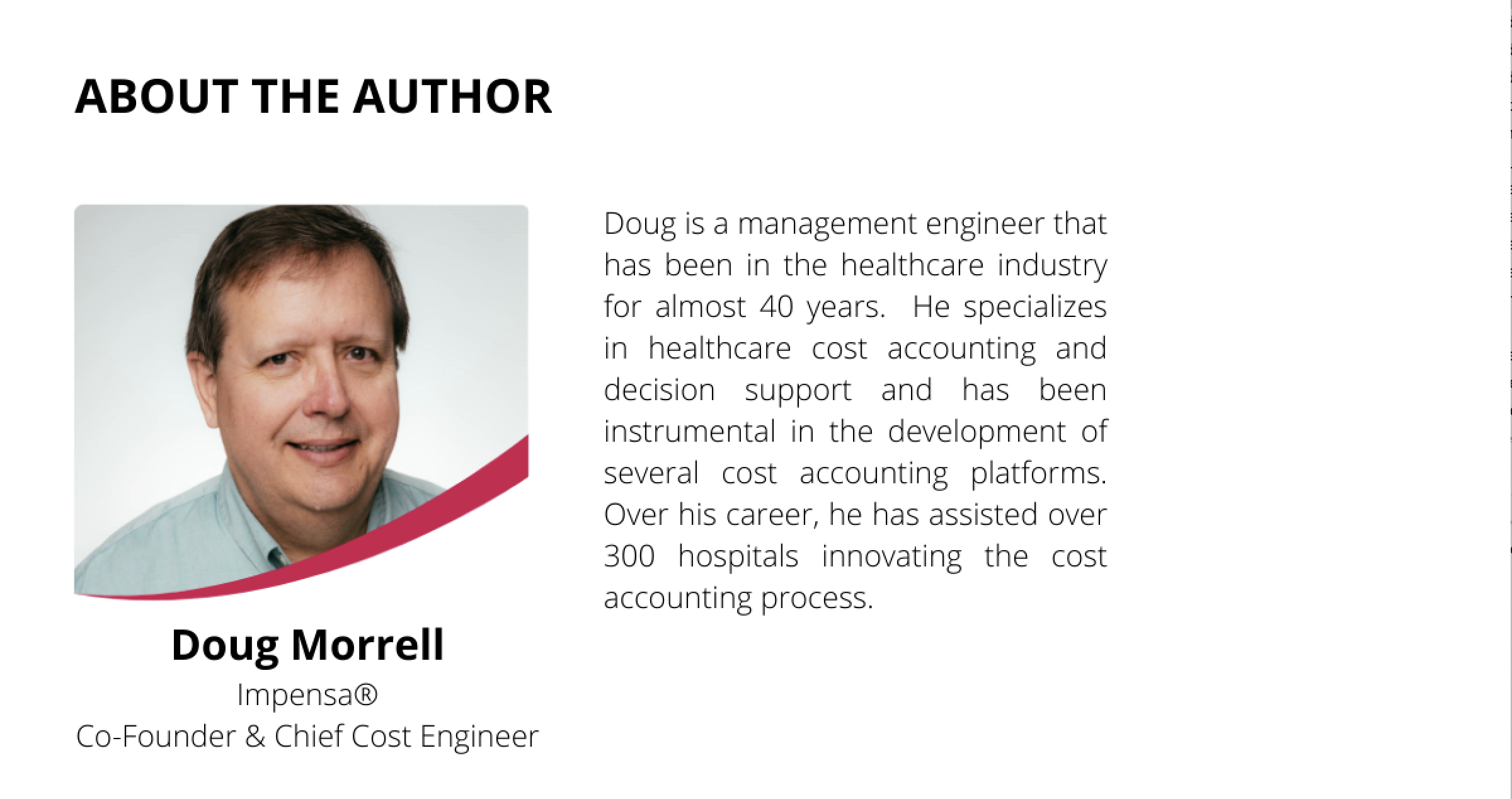Anyone who has been in the healthcare cost accounting profession for more than a few years may have observed the science and technology of costing is not advancing.
While the vendors don’t hesitate to tout pie-in-the-sky capabilities, what the users end up with falls quite short of expectations. If you’re of the opinion that cost accounting with cost to charge ratios (RCC) is sufficient, stop reading now, I won’t attempt to change your mind. In this series, I’ll propose thought-provoking ideas to revolutionize healthcare costing. Let’s take cost accounting to the next level.
Introduction
Cost accounting in healthcare first gained traction with the advent of DRG case-based reimbursement in the mid-1980s. Reimbursement based on cost was phased out (for the most part). Hospitals soon realized that calculating margins of various patient cohorts required insight into the actual cost required to care for a patient. It was the dawn of “business intelligence” in healthcare, or so we thought.
Unfortunately, as many organizations jumped into the cost accounting pool, they found it required some financial commitment to maintain, which was too much for some. Many reverted to the Medicare Cost Report security blanket and its use of RCC for cost calculation. Others kept moving forward with relative value unit (RVU) costing and its variations. The cost accounting science stagnated until the advent of the modern EHR, and the treasure trove of data captured within systems from Epic, Oracle/Cerner, etc. Savvy cost accountants thought, with a little data mining, secrets would be revealed, and “true” costs would be at their fingertips. Ten years on with most EHRs, this vision has not really materialized. Why? Many roadblocks stand in the way, but the biggest one is the connection of cost accounting to the Charge Master.
Let’s Get a Divorce
Cost accounting has been explicitly linked to the Charge Description Master (CDM) since its inception. The CDM was the most readily available data element recording services provided to a patient. Costs within a cost center were attributed to the CDM items used in that cost center via an RVU allocation or RCC. When performing cost accounting studies, we would tell clinicians “If you don’t charge for it, we don’t know about it.”
However, the CDM has always had its issues for cost accounting. It is a tool designed for reimbursement. For some services, it is too ambiguous (inpatient and observation nursing care, ER visit). Or it allows for multiple charges for a patient procedure (Cath Lab, Interventional Radiology). We used to recommend the use of “statistic-only” CDM items, but then revenue cycle managers would push back, accusing us of “cluttering up” their charge master. The basic problem with costing from the CDM is that it is not sensitive to the inevitable care variations which occur from patient to patient.
It is time for cost accounting to separate itself (a “divorce”, of sorts) from the CDM. Cost accounting needs – and deserves – its own foundational element upon which to capture resource consumption patient by patient: a Cost Master.
What is a Cost Master?
Every department in a hospital performing or supporting patient care has specific “events” which correlate to resource consumption (labor, supplies, equipment, etc.). Some events may be captured via the CDM (lab tests), but many are not. For this reason, each department should be studied carefully to determine which events are “cost drivers” and in which system can these events be captured. You may think this sounds like Activity-Based Costing (ABC), but there is an important difference. True ABC gets bogged down in trying to quantify a myriad of activities unrelated to patient care. In Event-Based Costing (EBC), we’re mining the patient record for those specific events (or activities) related to patient care. These events are built into the Cost Master table at the cost center level. This enables events to be customized to the exact setting as it exists in each cost center.
The Cost Master can mix CDM items with Events as needed. Each entry in the Cost Master should be labeled as to its type. Many events can be time-stamped and, at the transaction level, the exact resources (people) used can be captured to provide a very granular accounting of cost consumed. In cases where the time stamp data are ambiguous or missing elements, algorithms can be developed to substitute data based on other data elements or historical averages.
Cost Master Development Example
We’ll use hospital-based Diagnostic Imaging as an example of developing cost drivers to be captured and quantified in a Cost Master. When talking to department management, they might say the following parameters have the highest impact to cost required to complete any given exam:
- Mobility of patient (“walkie-talkie” or on a gurney)
- Age of patient (peds take more time)
- Location of exam (department or at the bedside)
- Exam being done
- Size of patient (extra staff needed)
- Conscious sedation required
In a facility with RFID tags embedded in employee badges and RFID detectors/collectors positioned at the entrance to each exam room, it is possible to automatically capture in/out times of staff participating in a procedure. In this case, the event is the exam itself, and the cost is the accumulated time of all persons involved.
Most facilities do not have an RFID backbone to support such detailed data collection. In that case, query code is written to mine the EHR for the patient parameters noted above. The parameters become “events” in the cost master with an associated time and skill level requirement. This approach shares some aspects of RVU costing, however, we’ve not used the CDM to define the events driving cost consumption. We have a much clearer view into those parameters which truly make a difference.
Conclusion
Each department or service has its own unique requirements for capturing resource consumption. The CDM has been the default cost accounting basis for decades, but its usefulness has always been limited. As you seek to improve your costing capabilities, look at it from a “cost master” perspective to get the bigger picture.





